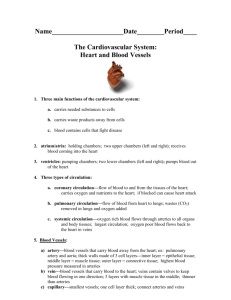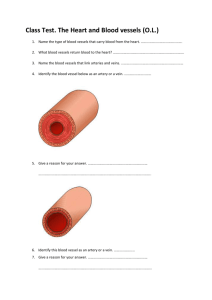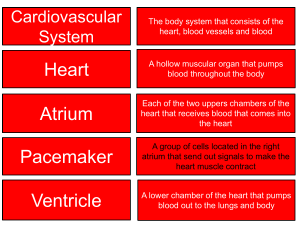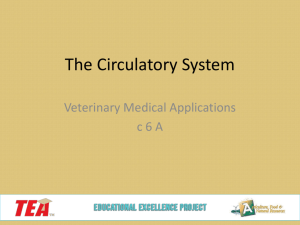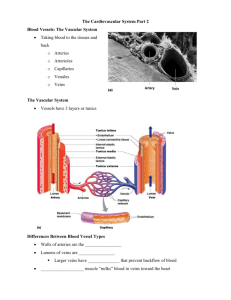Document
advertisement
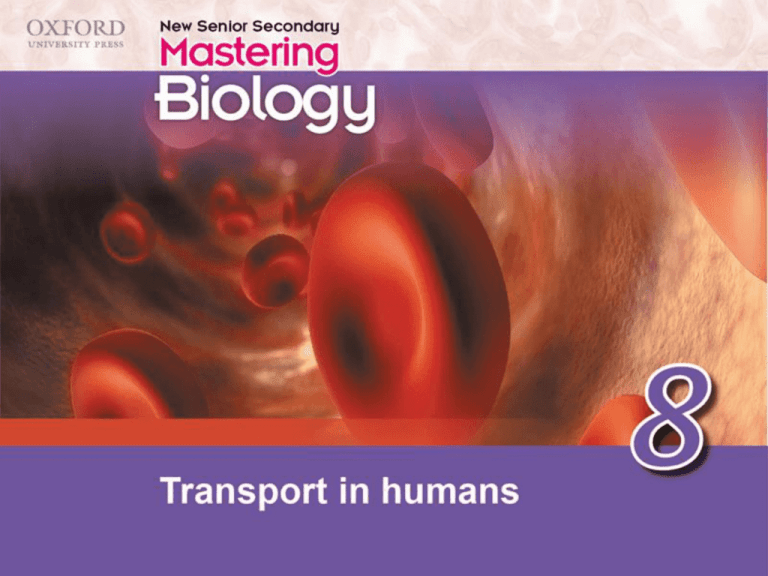
1 Think about… 8.1 The transport system 8.2 The blood 8.3 The blood vessels 8.4 The heart 8.5 Blood circulation 8.6 Exchange of materials between blood and body cells 8.7 Lymphatic system Recall ‘Think about…’ Summary concept map 2 The patient has lost a lot of blood. He needs blood transfusion. 3 donated blood blood donor 4 donated blood 5 artificial blood bacteria producing haemoglobin 6 1 What are the functions of blood in our body 7 2 What is haemoglobin What is its role in the body 8 3 Can artificial blood totally replace donated blood Why 9 8.1 The transport system In our city: • transport system to carry goods and people around 10 8.1 The transport system How are substances moved in organisms? 11 8.1 The transport system In very small organisms: O2 nutrients waste • by diffusion 12 8.1 The transport system In multicellular organisms: substances need to move long distance • by a transport system 13 8.1 The transport system human transport system circulatory system (循環系統) lymphatic system (淋巴系統) 14 8.1 The transport system Human circulatory system blood • carries nutrients and waste 15 8.1 The transport system Human circulatory system blood vessels (血管) • distributed throughout the body 16 8.1 The transport system Human circulatory system heart • as a pump to drive blood 17 8.1 The transport system 1 Humans are multicellular organisms. A transport system is needed to carry substances from one place to another over long distances within the body. 18 8.1 The transport system 2 The human circulatory system consists of: blood blood vessels heart 19 8.2 The blood What is the composition? 20 8.2 The blood Composition of blood centrifugation 21 8.2 The blood Composition of blood plasma blood cells 22 8.2 The blood 1 Plasma • 90% water • 10% soluble substances 23 8.2 The blood 1 Plasma • 10% soluble substances - plasma proteins - nutrients - waste - respiratory gases - hormones 24 8.2 The blood 2 Blood cells 25 8.2 The blood 2 Blood cells blood platelet red blood cell white blood cell 26 8.2 The blood 2 Blood cells Shape Red White blood cells blood cells Biconcave Irregular disc Blood platelets Small & irregular 27 8.2 The blood 2 Blood cells Red White blood cells blood cells Nucleus No Large Colour Red Blood platelets No Colourless Colourless due to haemoglobin 28 8.2 The blood 2 Blood cells Size Red White Blood blood cells blood cells platelets Small Phagocyte: < red (7-8 μm)* large blood cells (10-29 μm)* (1-4 μm)* Lymphocyte: small (6-10 μm)* * Diameter 29 8.2 The blood 2 Blood cells Red White blood cells blood cells 7000 Number 5.4 million (/mm3) Blood platelets 250 000 Function Blood clotting Carrying oxygen Killing germs by haemoglobin 30 8.2 The blood 2 Blood cells Red White blood cells blood cells Made in Bone Bone marrow marrow, spleen Life span Blood platelets Bone marrow 120 days A few days A few days 31 8.2 The blood 2 Blood cells Red White Blood blood cells blood cells platelets Break Liver and Killed by Liver and spleen down in spleen germs; Passed out in faeces 32 8.2 The blood 8.1 Examination of a blood smear 1 Examine a blood smear with a microscope. 33 8.2 The blood 8.1 2 Identify different blood cells. Draw high power diagrams of them. red blood cell phagocyte lymphocyte 34 8.2 The blood 8.1 3 Observe any differences between the blood cells. 35 8.2 The blood What are the functions of blood? 36 8.2 The blood Functions of blood 1 Transport of substances Red blood cells oxygen 37 8.2 The blood Functions of blood 1 Transport of substances Plasma carbon dioxide nutrients urea hormones heat antibodies 38 8.2 The blood Functions of blood 2 Protection against diseases Phagocyte • engulfs and digests germs by phagoctosis 39 8.2 The blood Functions of blood 2 Protection against diseases Lymphocyte • produces antibodies kill germs or neutralize toxins 40 8.2 The blood Functions of blood 2 Protection against diseases Blood platelets • help in blood clotting prevents further blood loss and entry of germs through the wounds 41 8.2 The blood 1 blood plasma blood platelet blood cells red blood cell white blood cell 42 8.2 The blood 2 Functions of blood: Plasma carries heat and dissolved substances 43 8.2 The blood 2 Functions of blood: Red blood cells contain haemoglobin to carry oxygen 44 8.2 The blood 2 Functions of blood: White blood cells protect us against diseases 45 8.2 The blood 2 Functions of blood: Blood platelets help in blood clotting 46 8.3 The blood vessels Three types of heart blood vessels venae cavae aorta • arteries • veins arteries veins • capillaries arterioles venules capillaries 47 8.3 The blood vessels artery (動脈) arteriole (小動脈) venule (小靜脈) capillary network (微血管網) vein (靜脈) 48 8.3 The blood vessels Arteries and veins artery vein 49 8.3 The blood vessels Arteries and veins thin layer of fibrous tissue thick layer of muscles and elastic tissue thicker wall artery smaller lumen 50 8.3 The blood vessels Arteries and veins thick layer of fibrous tissue thin layer of muscles and elastic tissue thinner wall larger lumen vein 51 8.3 The blood vessels Arteries and veins artery vein Why do arteries have a thicker muscular wall? 52 8.3 The blood vessels Arteries and veins thick muscular wall contracts and relaxes diameter changed regulates amount of blood flow 53 8.3 The blood vessels Arteries and veins artery vein Why do artery walls contain more elastic fibres? 54 8.3 The blood vessels Arteries and veins when heart relaxes arteries recoil (反衝) continuous blood flow 55 8.3 The blood vessels Arteries and veins Direction of blood flow Vein Artery Towards the Away from heart the heart vein artery 56 8.3 The blood vessels Arteries and veins Vein Nature of blood Artery Deoxygenated Oxygenated deoxygenated blood (not in pulmonary vein and umbilical vein) oxygenated blood (not in pulmonary artery and umbilical artery) 57 8.3 The blood vessels Arteries and veins Vein Wall vein (fewer elastic fibres) Thinner Artery Thicker artery (more elastic fibres) 58 8.3 The blood vessels Arteries and veins Vein Lumen large lumen (resistance ) Large Artery Small small lumen 59 8.3 The blood vessels Arteries and veins Vein Blood pressure Low due to resistance in capillaries Artery High due to pumping of heart 60 8.3 The blood vessels Arteries and veins Vein Force for blood flow Contraction of muscles Artery Pumping of heart contraction pumping squeeze veins blood flow blood flow 61 8.3 The blood vessels Arteries and veins Vein Presence of Present valves prevent backflow of blood Artery Absent except at the base of pulmonary artery and aorta 62 8.3 The blood vessels Arteries and veins to heart vein valve muscle 1 Muscles contract. 2 They press against the vein. 63 8.3 The blood vessels Arteries and veins to heart 3 The vein is squeezed. 4 The blood is forced to flow. 64 8.3 The blood vessels Arteries and veins to heart 5 Muscles relax. 6 Valves prevent blood from flowing back. 65 8.3 The blood vessels Arteries and veins Vein Location Artery Close to Deep inside body surface the body 66 8.3 The blood vessels 8.2 Examination of the transverse sections of an artery and a vein 1 Examine the transverse sections of an artery and a vein with a microscope. artery vein 67 8.3 The blood vessels 8.2 2 Draw labelled diagrams of the artery and the vein. 3 Observe any structural differences between them. 68 8.3 The blood vessels artery (動脈) arteriole (小動脈) venule (小靜脈) capillary network (微血管網) vein (靜脈) 69 8.3 The blood vessels Capillaries small lumen one-cell thick capillary wall differentially permeable 70 8.3 The blood vessels Capillaries capillary wall outside inside 71 8.3 The blood vessels Capillaries outside inside • small substances, e.g. O2, glucose and metabolic waste can pass through 72 8.3 The blood vessels Capillaries outside inside • blood cells and proteins are too large to pass through 73 8.3 The blood vessels Adaptations 1 Capillary bed (微血管床) • large surface area for rapid exchange capillary bed 74 8.3 The blood vessels Adaptations 2 Large total cross-sectional area 75 8.3 The blood vessels Adaptations capillary (T.S.) 2 Large total cross-sectional area 76 8.3 The blood vessels Adaptations 2 Large total cross-sectional area • blood flows slowly to allow longer period of time for exchange 77 8.3 The blood vessels Adaptations 3 One-cell thick capillary wall • short diffusion distance for rapid exchange one-cell thick capillary wall 78 8.3 The blood vessels 8.3 Video Examination of the capillary flow in a fish tail fin 1 Wrap a small living fish in moist paper towels and put it in a Petri dish. Put a slide over the tail fin. 79 8.3 The blood vessels 8.3 2 Using low power magnification of a microscope or an image analysing device, observe the movement of blood in the capillary network in the tail fin. red blood cell 80 8.3 The blood vessels 8.3 Results of observation The blood flow in the capillary network is quite slow. The direction of flow is one way. Red blood cells have a similar diameter to that of the capillaries. red blood cell 81 8.3 The blood vessels Blood pressure blood pressure pumping of heart: • blood pressure high & changes periodically artery arteriole 82 8.3 The blood vessels Blood pressure blood pressure narrow diameter: • high resistance blood pressure drops artery capillary arteriole 83 8.3 The blood vessels Blood pressure blood pressure long distance from heart: • great friction blood pressure further drops artery capillary vein arteriole venule 84 8.3 The blood vessels 1 aorta branches into arteries pumps blood into branch into heart drain blood into join to form join to form 85 8.3 The blood vessels arterioles branch into a network of capillaries (exchange of materials) venules join to form 86 8.3 The blood vessels 1 aorta branches into arteries pumps blood into branch into heart drain blood into venae cavae veins join to form join to form 87 8.3 The blood vessels 2 Arteries: • carries oxygenated blood (except pulmonary artery and umbilical artery) 88 8.3 The blood vessels 2 Arteries: • wall contains thick layer of muscles muscles to regulate the blood flow • elastic elastic fibres recoil to maintain blood flow 89 8.3 The blood vessels 2 Veins: • carries deoxygenated blood (except pulmonary vein and umbilical vein) 90 8.3 The blood vessels 2 Veins: • large lumen to reduce resistance to blood flow • valves present to prevent backflow backflow of blood blood flows in one direction 91 8.3 The blood vessels 2 Capillaries: • allows exchange exchange of materials between blood and body cells 92 8.3 The blood vessels 2 Capillaries: • branching increases surface area area for diffusion cross-sectional area • large total cross-sectional blood flows slowly more time for material exchange 93 8.3 The blood vessels 2 Capillaries: • one-cell thick capillary wall provides short diffusion distance 94 8.3 The blood vessels 3 Movement of blood: In arteries: In veins: pumping action action of pumping the heart contraction of contraction muscles lying next to the veins 95 8.3 The blood vessels 4 Blood pressure: In arteries: In arterioles: high gradually drops In capillaries: a great drop due to narrow diameter 96 8.3 The blood vessels 4 Blood pressure: In veins: becomes even lower as the blood has overcome great friction friction and travelled a long distance 97 8.4 The heart 3D Model • in the thoracic cavity between the two lungs 98 8.4 The heart • about the size of a fist (拳) 99 8.4 The heart • weighs about 300 g 100 8.4 The heart • surrounded by pericardium (圍心膜) 101 8.4 The heart • mainly made up of cardiac muscles (心肌) 102 8.4 The heart Structure of the heart right atrium (右心房) right ventricle (右心室) left atrium (左心房) left ventricle (左心室) 103 8.4 The heart Structure of the heart anterior vena cava posterior vena cava aorta pulmonary artery pulmonary veins coronary artery coronary vein 104 8.4 The heart Structure of the heart • coronary arteries (冠狀動脈) - receive blood from aorta - supply oxygen and nutrients to cardiac muscles • coronary veins (冠狀靜脈) - carry away carbon dioxide and waste 105 8.4 The heart Structure of the heart 106 8.4 The heart Structure of the heart right atrium right ventricle left atrium left ventricle 107 8.4 The heart Structure of the heart pulmonary artery anterior vena cava aorta pulmonary veins posterior vena cava 108 8.4 The heart Structure of the heart semilunar valves tricuspid valve bicuspid valve septum 109 8.4 The heart Structure of the heart • septum prevents mixing of blood on the two sides deoxygenated blood oxygenated blood 110 8.4 The heart Structure of the heart right atrium right ventricle left atrium left ventricle 111 8.4 The heart Atria • thin muscular wall 112 8.4 The heart Atria deoxygenated blood from head & arms anterior vena cava 113 8.4 The heart Atria deoxygenated blood from head & arms posterior vena cava deoxygenated blood from legs & abdomen pulmonary veins oxygenated blood from lungs 114 8.4 The heart Structure of the heart right atrium right ventricle left atrium left ventricle 115 8.4 The heart Ventricles • thick muscular wall 116 8.4 The heart Ventricles • left ventricle has thicker muscular wall right left 117 8.4 The heart Ventricles Animation right atrium left atrium right ventricle left ventricle pulmonary artery aorta rest of body lungs 118 8.4 The heart Structure of the heart semilunar valves tricuspid valve bicuspid valve septum 119 8.4 The heart Heart valves 120 8.4 The heart Heart valves tricuspid valve (3 flaps) aorta semilunar valves bicuspid valve (2 flaps) pulmonary artery 121 8.4 The heart Heart valves Bicuspid valve and tricuspid valve • prevent backflow of blood into atria 122 8.4 The heart Heart valves Bicuspid valve and tricuspid valve • held by tough heart tendons (心腱索) 123 8.4 The heart Heart valves Bicuspid valve and tricuspid valve • held by tough heart tendons (心腱索) prevent valves from turning inside out 124 8.4 The heart Heart valves Semilunar valves • prevent backflow of blood into ventricles 125 8.4 The heart 8.4 Video Dissection and examination of a pig heart 1 Identify the left and right sides, the dorsal and ventral sides, and the major blood vessels of a pig heart. 126 8.4 The heart 8.4 2 Run water slowly into each of the four major blood vessels in turn. Observe what happens. 127 8.4 The heart 8.4 3 Cut the ventricles from the bottom into two halves horizontally. First along the left side, then along the middle and lastly along the right side. Remove the ventral halves of the ventricles. ventral side 128 8.4 The heart 8.4 4 Cut the atria into two halves to show the valves. Remove the ventral halves of the atria. Cut open the base of the pulmonary artery and identify the semilunar valves inside. pulmonary artery 129 8.4 The heart 8.4 5 Move the pulmonary artery sideways to the left. Then cut open the base of the aorta and identify the semilunar valves inside. aorta 130 8.4 The heart Adaptation of the heart as an effective pumping organ 1 Cardiac muscles can contract and relax continuously 131 8.4 The heart Adaptation of the heart as an effective pumping organ 2 Ventricles have thick muscular wall 132 8.4 The heart Adaptation of the heart as an effective pumping organ 3 Bicuspid valve, tricuspid valve and semilunar valves prevent backflow of blood 133 8.4 The heart Adaptation of the heart as an effective pumping organ 4 Heart tendons prevent bicuspid and tricuspid valves from turning inside out 134 8.4 The heart 1 The coronary arteries supply oxygen and nutrients to the cardiac muscles. The coronary veins carry away carbon dioxide and other waste from the cardiac muscles. 135 8.4 The heart 2 The heart consists of four chambers: right atrium right ventricle left atrium left ventricle 136 8.4 The heart 2 Valves also present to prevent backflow of blood: semilunar valves tricuspid valve bicuspid valve 137 8.4 The heart 3 Blood vessels that carry blood into and out of the heart: venae cavae carry deoxygenated blood into the heart 138 8.4 The heart 3 Blood vessels that carry blood into and out of the heart: pulmonary artery carries deoxygenated blood to the lungs 139 8.4 The heart 3 Blood vessels that carry blood into and out of the heart: carry oxygenated blood into the heart pulmonary veins 140 8.4 The heart 3 Blood vessels that carry blood into and out of the heart: carries oxygenated blood to all parts of body aorta 141 8.5 Blood circulation blood circulation pulmonary circulation (肺循環) systemic circulation (體循環) 142 8.5 Blood circulation pulmonary artery pulmonary circulation venae cavae aorta pulmonary veins right left 143 8.5 Blood circulation pulmonary artery systemic circulation venae cavae aorta pulmonary veins right left all other parts of the body 144 8.5 Blood circulation blood circulation pulmonary circulation (肺循環) systemic circulation (體循環) 145 8.5 Blood circulation 1 Pulmonary circulation 1 Right ventricle contracts. 146 8.5 Blood circulation 1 Pulmonary circulation pulmonary artery 2 Deoxygenated blood is pumped to the lungs. 147 8.5 Blood circulation 1 Pulmonary circulation 3 Gas exchange takes place. lungs 148 8.5 Blood circulation 1 Pulmonary circulation 4 Oxygenated blood returns to the left atrium. pulmonary veins 149 8.5 Blood circulation 2 Systemic circulation 1 Oxygenated blood flows from left atrium to left ventricle. body parts (except lungs) 150 8.5 Blood circulation 2 Systemic circulation 2 Left ventricle contracts. body parts (except lungs) 151 8.5 Blood circulation 2 Systemic circulation 3 Blood is pumped to all body parts (except the lungs). aorta body parts (except lungs) 152 8.5 Blood circulation 2 Systemic circulation 4 Exchange of materials takes place, the blood becomes deoxygenated. body parts (except lungs) 153 8.5 Blood circulation 2 Systemic circulation venae cavae 5 Deoxygenated blood returns to the right atrium through veins. body parts (except lungs) 154 8.5 Blood circulation 2 Systemic circulation aorta 155 8.5 Blood circulation 2 Systemic circulation head, neck, arms anterior vena cava 156 8.5 Blood circulation 2 Systemic circulation posterior vena cava aorta 157 8.5 Blood circulation 2 Systemic circulation hepatic vein liver hepatic artery 158 8.5 Blood circulation 2 Systemic circulation liver hepatic portal vein (nutrient-rich blood) small intestine 159 8.5 Blood circulation 2 Systemic circulation posterior vena cava 1 After digestion, nutrient-rich blood is passed to liver through hepatic portal vein. aorta 160 8.5 Blood circulation 2 Systemic circulation 2 The blood then flows through hepatic vein and posterior vena cava to the heart. posterior vena cava aorta 161 8.5 Blood circulation 1a In the pulmonary circulation: The right ventricle pumps deoxygenated blood through the pulmonary artery to the lungs lungs for gas exchange. 162 8.5 Blood circulation 1a In the pulmonary circulation: The oxygenated blood flows through pulmonary veins to the left atrium . 163 8.5 Blood circulation 1b In the systemic circulation: The oxygenated blood flows from the left atrium to the leftventricle ventricle . left 164 8.5 Blood circulation 1b In the systemic circulation: The left ventricle then pumps the blood through aorta to all parts of the body except the lungs lungs . 165 8.5 Blood circulation 1b In the systemic circulation: Exchange of materials takes place in the capillary bed. The blood becomes deoxygenated . 166 8.5 Blood circulation 1b In the systemic circulation: The deoxygenated blood returns to the right atrium through the venae cavae . 167 8.6 Exchange of materials between blood and body cells • takes place at capillaries 168 8.6 Exchange of materials between blood and body cells • takes place at capillaries How does it take place? 169 8.6 Exchange of materials between blood and body cells Exchange of materials plasma capillary red blood cell tissue fluid body cell 170 8.6 Exchange of materials between blood and body cells Exchange of materials O2 171 8.6 Exchange of materials between blood and body cells Exchange of materials nutrients, O2 water CO2 waste 172 8.6 Exchange of materials between blood and body cells Exchange of materials How is tissue fluid formed? 173 8.6 Exchange of materials between blood and body cells Formation of tissue fluid blood flow capillary arteriole lymph capillaries (淋巴微管) tissue fluid body cells venule 174 8.6 Exchange of materials between blood and body cells Formation of tissue fluid Arteriole end pressure of blood higher than pressure of fluid surrounding the body cells 175 8.6 Exchange of materials between blood and body cells Formation of tissue fluid some components of plasma are forced out to form tissue fluid 176 8.6 Exchange of materials between blood and body cells Formation of tissue fluid some components of plasma are forced out to form tissue fluid outside inside H2O minerals sugars fats hormones 177 capillary wall 8.6 Exchange of materials between blood and body cells Formation of tissue fluid some components of plasma are forced out to form tissue fluid outside inside WBC white blood cells squeeze through 178 capillary wall 8.6 Exchange of materials between blood and body cells Formation of tissue fluid some components of plasma are forced out to form tissue fluid white blood cells squeeze through outside inside RBC platelets plasma proteins some are too large → remain in blood 179 capillary wall 8.6 Exchange of materials between blood and body cells Formation of tissue fluid Venule end water potential of tissue fluid higher than water potential of blood 180 8.6 Exchange of materials between blood and body cells Formation of tissue fluid water in tissue fluid is drawn into capillaries by osmosis 181 8.6 Exchange of materials between blood and body cells Formation of tissue fluid small amount of tissue fluid drains into lymph capillaries 182 8.6 Exchange of materials between blood and body cells Why are all body cells bathed in tissue fluid? 183 8.6 Exchange of materials between blood and body cells Importance of tissue fluid 1 Provides a constant environment for the body cells 2 Serves as an important link for the exchange of materials between capillaries and body cells 184 8.6 Exchange of materials between blood and body cells 1a At the capillaries, useful materials are forced out of the blood into the tissue fluid and then diffuse into the body cells. 185 8.6 Exchange of materials between blood and body cells 1b Waste products from the body cells diffuse into the tissue fluid and then diffuse through the capillary wall into the blood . 186 8.6 Exchange of materials between blood and body cells 2 Blood pressure in the capillaries is higher than the pressure of fluid surrounding the body cells. plasma Some plasma except plasma protein protein is forced out of the capillaries to form the tissue fluid. 187 8.6 Exchange of materials between blood and body cells 2 White blood cells can squeeze through the capillary wall and enter the tissue fluid. 188 8.7 Lymphatic system capillary What are lymph capillaries? arteriole lymph capillaries (淋巴微管) tissue fluid body cells venule 189 8.7 Lymphatic system • part of lymphatic system capillary • tissue fluid inside is called arteriole tissue fluid lymph (淋巴) body cells lymph capillaries (淋巴微管) venule 190 8.7 Lymphatic system Components of lymphatic system lymph vessel (淋巴管) lymph node (淋巴結) group of lymph nodes 191 8.7 Lymphatic system Components of lymphatic system lymph vessels join to two large veins, returning lymph into blood 192 8.7 Lymphatic system 1 Lymph capillaries and vessels • lymph capillaries are blind-ended join to form lymph vessels 193 8.7 Lymphatic system 1 Lymph capillaries and vessels flow of lymph in lymph vessels ~ blood flow in veins contraction of muscles presence of valves 194 8.7 Lymphatic system 1 Lymph capillaries and vessels • to prevent backflow of lymph valve presence of valves 195 8.7 Lymphatic system 2 Lymph nodes • at intervals along lymph vessels 196 8.7 Lymphatic system 2 Lymph nodes space filled with white blood cells lymph vessel 197 8.7 Lymphatic system 2 Lymph nodes space filled with white blood cells lymph vessel 198 8.7 Lymphatic system Functions of lymphatic system 1 Collects and returns excess tissue fluid to the blood 199 8.7 Lymphatic system Functions of lymphatic system 2 Protects us against diseases by white blood cells white blood cells 200 8.7 Lymphatic system Functions of lymphatic system 3 Transports lipids In the small intestine, lipids are absorbed into lacteals in the villi. 201 8.7 Lymphatic system Functions of lymphatic system 3 Transports lipids In the small intestine, lipids are absorbed into lacteal in the villi. lacteals villus 202 8.7 Lymphatic system 1 Lymphatic system consists of: lymph capillary collects excess tissue fluid as lymph lymph vessels formed by joining lymph capillaries lymph nodes found at intervals along lymph vessels 203 8.7 Lymphatic system 2 Lymph is driven forwards inside lymph vessels by contraction of muscles muscles surrounding the vessels. Valves are also present in the lymph vessels to prevent backflow of lymph. 204 8.7 Lymphatic system 3 Functions of lymphatic system: • transports tissue fluid back to the blood 205 8.7 Lymphatic system 3 Functions of lymphatic system: • filters out germs from lymph at lymph nodes 206 8.7 Lymphatic system 3 Functions of lymphatic system: • transports lipids from lacteals in intestinal villi to the blood 207 1 What are the functions of blood in our body? Blood is the transport medium in our body. It is also important in protecting us against diseases. 208 2 What is haemoglobin? What is its role in the body? Haemoglobin in red blood cells acts as oxygen carriers. 209 3 Can artificial blood totally replace donated blood? Why? Artificial blood consisting mainly of haemoglobin can carry oxygen to the organs. However, it cannot serve for other functions of blood, such as defence against diseases and blood clotting. 210 Transport in humans is provided by circulatory system lymphatic system consists of heart blood blood vessels 211 blood made up of plasma blood cells include red white blood cells blood cells blood platelets 212 lymphatic system consists of lymph vessels have swellings called lymph nodes lymph formed from tissue fluid 213

